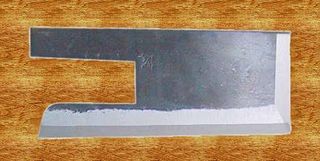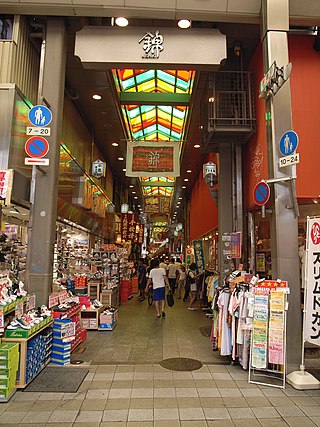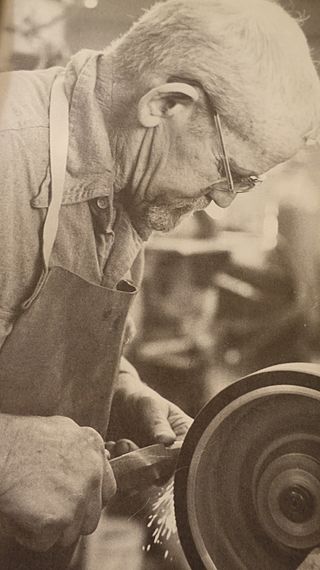
A knife is a tool or weapon with a cutting edge or blade, usually attached to a handle or hilt. One of the earliest tools used by humanity, knives appeared at least 2.5 million years ago, as evidenced by the Oldowan tools. Originally made of wood, bone, and stone, over the centuries, in step with improvements in both metallurgy and manufacturing, knife blades have been made from copper, bronze, iron, steel, ceramic, and titanium. Most modern knives have either fixed or folding blades; blade patterns and styles vary by maker and country of origin.

Deba bōchō are Japanese style kitchen knives primarily used to cut fish, though also used when cutting meat. They come in different sizes, sometimes up to 30 cm (12 inches) in length. The deba bōchō first appeared during the Edo period in Sakai. It is designed to behead and fillet fish. Its thickness, and often a more obtuse angle on the back of the heel allow it to cut off the heads of fish without damage. The rest of the blade is then used to ride against the fish bones, separating the fillet.

A Japanese kitchen knife is a type of a knife used for food preparation. These knives come in many different varieties and are often made using traditional Japanese blacksmithing techniques. They can be made from stainless steel, or hagane, which is the same kind of steel used to make Japanese swords. Most knives are referred to as hōchō or the variation -bōchō in compound words but can have other names including -kiri. There are four general categories used to distinguish the Japanese knife designs: handle, blade grind, steel, and construction.
Sashimi bōchō, literally "sashimi knife" is a type of long, thin knife used in Japanese cuisine to prepare sashimi. Types of sashimi bōchō include tako hiki, yanagi ba, and fugu hiki.

The udon kiri, soba kiri, and kashi kiri are a group of specialized knives used in the Japanese kitchen to make udon and soba noodles respectively. The udon kiri is also sometimes called menkiri bocho, and is distinguished from the Soba and Kashi kiri knives by a blade that drops in to cover less than half of the length of the handle rather that reaching the end of the handle like the soba. The soba kiri is characterized by a long blade that spans down the full length of the handle whereas the blade of the Kashi kiri only curves to meet the top of the handle. To make soba or udon the dough is flattened and folded, and then cut with the menkiri bocho to produce long rectangular noodles. For this purpose the menkiri bocho has a straight and long cutting edge to cut the noodles straight to the board. The knife is usually heavy to aid in the cutting of the noodles, usually with a slight forward motion.

A kitchen knife is any knife that is intended to be used in food preparation. While much of this work can be accomplished with a few general-purpose knives – notably a large chef's knife, a tough cleaver, a small paring knife and some sort of serrated blade – there are also many specialized knives that are designed for specific tasks. Kitchen knives can be made from several different materials.

The SOG Knife was designed for, and issued to, covert Studies and Observations Group personnel during the Vietnam War. It was unmarked and supposedly untraceable to country of origin or manufacture in order to maintain plausible deniability of covert operators in the event of their death or capture.

Christopher Stanley Reeve is a South African-American knife maker, recognized as one of the most influential people in knife making history. Reeve founded Chris Reeve Knives (CRK) in 1984. In 2014, Reeve retired and was inducted into the Blade Magazine Hall of Fame in 2015.

Bladesmithing is the art of making knives, swords, daggers and other blades using a forge, hammer, anvil, and other smithing tools. Bladesmiths employ a variety of metalworking techniques similar to those used by blacksmiths, as well as woodworking for knife and sword handles, and often leatherworking for sheaths. Bladesmithing is an art that is thousands of years old and found in cultures as diverse as China, Japan, India, Germany, Korea, the Middle East, Spain and the British Isles. As with any art shrouded in history, there are myths and misconceptions about the process. While traditionally bladesmithing referred to the manufacture of any blade by any means, the majority of contemporary craftsmen referred to as bladesmiths are those who primarily manufacture blades by means of using a forge to shape the blade as opposed to knifemakers who form blades by use of the stock removal method, although there is some overlap between both crafts.
Robert Waldorf Loveless, a.k.a. Bob Loveless or RW Loveless, was an American knife maker who designed and popularized the hollowground drop point blade and the use of full tapered tangs and screw-type handle scale fasteners within the art of knifemaking. He is cited by other knifemakers and collectors as one of the most innovative custom knife makers in the world.

Cold Steel, Inc. is an American retailer of knives/bladed tools, training weapons, swords and other martial arts edged and blunt weapons. Founded in Ventura, California, the company is currently based in Irving, Texas after an acquisition by GSM Outdoors in 2020. Cold Steel products are manufactured worldwide, including in the United States, Japan, mainland China, Taiwan, India, Italy and South Africa.
Phill Hartsfield was a Southern California sword and knifemaker based in Garden Grove who is noted for popularizing the chisel ground blade in the western world. Hartsfield's designs have influenced other knifemakers, primarily Ernest Emerson.

Nishiki Market is a marketplace in downtown Kyoto, located on the east end of Nishikikōji Street, one block north and parallel to Shijō Street and west of Teramachi Street. Rich with history and tradition, the market is renowned as the place to obtain many of Kyoto's famous foods and goods.
Emerson Knives, Inc. is an American company that produces knives and related products. It was founded in 1996 by custom knifemaker Ernest Emerson in an effort to mass-produce his folding knife designs for the U.S. Military and collector markets.

Al Mar Knives is a production knife company headquartered in Tualatin, Oregon, United States. Al Mar Knives was established in 1979 by Al Mar, and has a reputation for making tactical knives of innovative design. While headquartered in the United States, Al Mar knives were made in Seki City of Japan from 1979 to 2019.
James Buel Lile, known as Jimmy Lile and "The Arkansas Knifesmith", was an American knifemaker from Russellville in Pope County, Arkansas, who made the Rambo Knife for the films First Blood and Rambo: First Blood Part II. As a knifemaker Lile served as a president of the Knifemakers' Guild and on the board of directors of the American Bladesmith Society.
William Francis Moran Jr., also known as Bill Moran, was a pioneering American knifemaker who founded the American Bladesmith Society and reintroduced the process of making pattern welded steel to modern knife making. Moran's knives were sought after by celebrities and heads-of-state. The "William F. Moran School of Bladesmithing" bears his name and in addition to founding the ABS, he was a Blade Magazine Hall of Fame Member and a President of the Knifemakers' Guild.
Gil Hibben is an American custom knifemaker from Wyoming who is based in La Grange, Kentucky. Hibben designed the first line of Browning hunting knives in 1968, the American Kenpo Knife for Ed Parker, and the Rambo Knife for the 1988 film Rambo III 2008 film Rambo. Hibben's "Fantasy Knives" have been used in over 37 films and television shows, particularly science fiction, earning him the title "Klingon Armorer" from the Star Trek franchise. Hibben currently serves as a President of the Knifemakers' Guild, a post he has held for fourteen years.
Robert G. Terzuola is an American knife maker who popularized the type of knife known as the tactical folding knife.

John Nelson Cooper (1906–1987) was a custom knifemaker who was a founding member of the Knifemakers' Guild. He was a mentor to Jody Samson and made knives for over 60 years.













